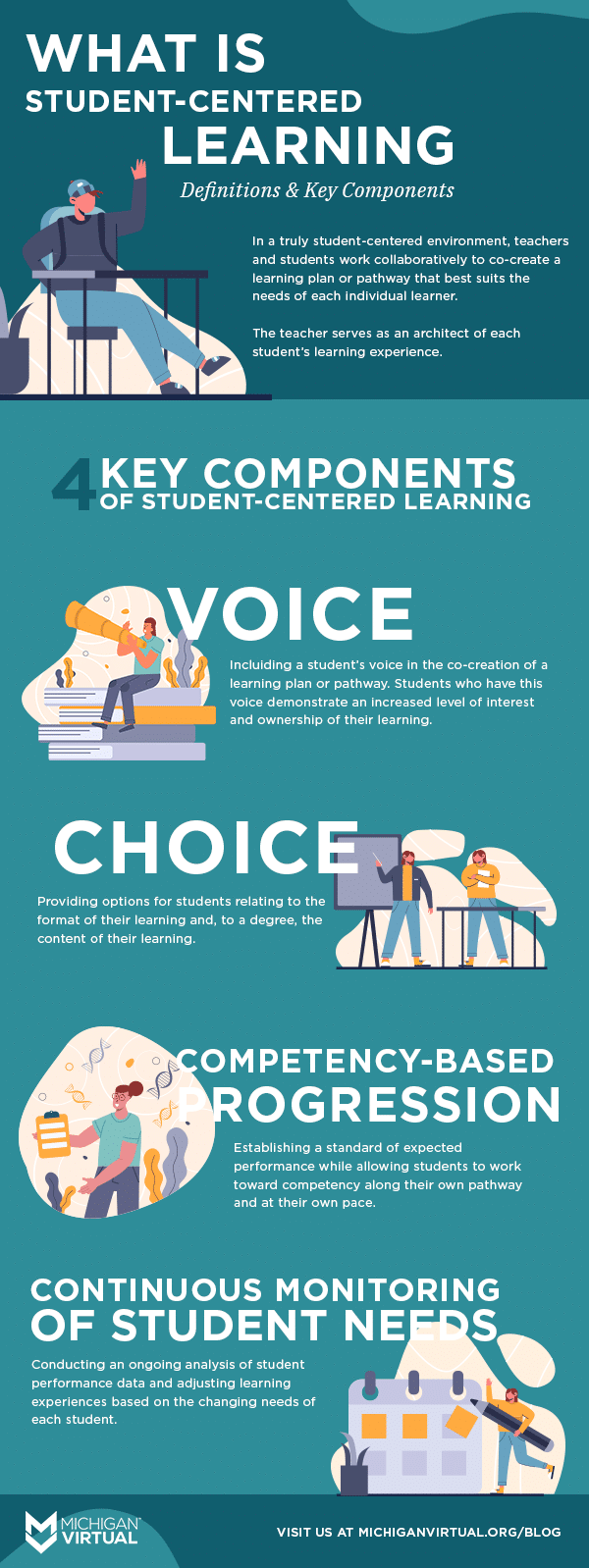As we approach fall 2020, schools are preparing for a “new normal,” which will most likely be far from it.
Whether schools are starting the year with in-person instruction, using a hybrid model, or teaching completely online, schools and teachers will need to be flexible. They may have to shift back and forth between different models of instruction throughout the school year.
As we wrap up our Student-Centered Learning blog series, this is the first post of four in our mini-series, Engage and Empower Learners: How Student-Centered Learning Supports Learning Continuity. In this mini-series, we will discuss how adopting student-centered learning principles can actually help school leaders and teachers facilitate the transition to this “new normal” of teaching and learning while still nurturing student growth.
In this first post, we will be revisiting two core tenets of student-centered learning: voice and choice. We will explore each one in more depth to understand why implementing student-centered principles into the learning environment can improve student engagement and make teaching and learning, no matter what environment you and your students find yourselves in, more student-focused.

Student choice: Tapping into learners’ strengths
As we discussed in the first post of our student-centered learning blog series, “What Exactly IS Student-Centered Learning?”, giving students choice means providing them with options and allowing students to choose what works best for them.
Giving students choice can mean giving students the ability to choose:
- the way in which they want to learn content,
- the process they use to learn the content,
- when they learn the content, and/or
- how to demonstrate their understanding of the content.
Giving students choice can provide an opportunity for learners to tap into their passions and strengths, allowing them to deviate from what everyone is doing and learn in a way that makes sense to them.
Improving student engagement
We know that during this time of distance learning, one of the challenges that schools have faced is disengaged students. This lack of student engagement can be a result of inequities in terms of technology, a lack of self-discipline and motivation, and/or not having a workspace at home that is conducive to learning.
In fact, the disengagement of students is a challenge for schools, whether instruction is virtual or face-to-face. So it is no wonder that this doesn’t improve, and can, in fact, be more challenging in an online learning environment.
However, the school leaders that we have worked with and spoken to indicated seeing higher levels of engagement in remote learning environments when students have choice.
Whether students have options related to the format of their learning, the content of their learning, or the manner in which their learning is assessed, providing choice can increase student engagement, student performance, and students’ perceived value of their learning.
Student voice: Encouraging student agency
As it relates to creating a student-centered learning environment, voice refers to students having the ability to shape and design their own learning, co-creating their learning plan or pathway.
Giving students voice may involve encouraging students to:
- share their ideas or understanding,
- design their own project or unit,
- set goals and monitor their own learning, and/or
- lead a conference, discussion, or presentation.
Related to the idea of voice is the concept of student agency—when students are active participants in their education, taking responsibility for their learning, and being given some degree of control in the process.
With student agency, the amount of control should vary from grade level to grade level, keeping in mind the degree of control that is age appropriate for students to have.
It is important to note the overlap that exists with voice, student agency, and with choice. Here is one way to think about it: choice encourages students to choose, from a set of options provided for them, the path or process that works best for them. Voice is when students are responsible for or included in designing their learning options.
Choice, voice, and student agency are all ways in which students are encouraged to take ownership of their learning.
Increased student ownership
In our conversations with school leaders and teachers, we know that those schools that already implement student voice and agency in their learning model made the transition to remote learning much more easily.
In the blog, “Student-Centered Learning At FlexTech High Schools,” FlexTech’s Director of School Leadership, Dr. Sarah Pazur, shared:
“Schools that have created the conditions for student agency are going to have an easier time with rapid or extended closures because students aren’t waiting on the adults or the system to tell them what to do. They [students] are inspired by the work they’re doing because they had a voice in shaping and designing it—they created it and it doesn’t live in the school building.”
Students who already had that agency expectation were able to move forward academically much more easily than others who have never had the experience of taking ownership of or shaping the path of their learning.
And their teachers, who were already functioning in a student-centered learning environment, continued to focus more on continued student learning rather than on teaching.
Incorporating voice can help students take ownership of their learning and rely less on their teacher to direct the process, resulting in higher levels of student engagement, empowerment, and hopefully achievement.
Final thoughts
Schools will look different this fall, there’s no doubt about that. However, the need to rapidly adopt virtual learning is no longer an emergency. We knew it was coming.
So what can we do differently this time?
What changes can we make now to benefit students not only for this school year, but in the years to come?
Giving students voice and choice—the opportunity to choose to learn the way they learn best and to direct some aspects of their learning—helps to make students feel personally invested in their learning and gives them a role in shaping and creating it rather than it being simply delivered to them.
In the blog, “Student-Centered Learning At Hamilton Community Schools,” superintendent of Hamilton Community Schools, Dave Tebo explained:
“Giving choice gives voice, but it requires a leap of faith, which is difficult for teachers to take—to empower students to make the decisions for themselves. Giving students ownership of their learning is a key component of a student-centered approach.”
No matter what environment teachers and students find themselves in, hopefully it is one where students are:
…deciding for themselves based on their interests and strengths
…given opportunities to design some part of their learning
…empowered, excited, and engaged
We encourage you to take a leap of faith. Try something different. Voice and choice may be just what you and your students need.
Student-centered learning blog series
In our Student-Centered Learning blog series, we lead a discussion each month about student-centered learning: what it is, how it can help students and schools, and how to make it a reality. Our hope with this series is to provide practical insights to school leaders, teachers, and parents on how to make education more meaningful to students. Stay up to date on future blogs in this series by signing up for email notifications!
About the authors
Christa Green
Christa received her master’s in Curriculum and Instruction from Kent State University, as well as a bachelor’s degree in Business Administration. She taught middle school language arts and social studies for seven years before coming to work for Michigan Virtual in 2018. As a research specialist with the Michigan Virtual Learning Research Institute, Christa enjoys using her passion for education, curriculum, research, and writing to share and shape best practices in online and blended learning with other educators within and beyond Michigan.
Christopher Harrington
Dr. Christopher Harrington has served public education as a teacher, an administrator, a researcher, and a consultant for more than 25 years and has experience assisting dozens of school districts across the nation in the design and implementation of blended, online, and personalized learning programs. He has worked on local, regional, and national committees with the Aurora Institute (formerly iNACOL) and various other education-based organizations aimed at transforming education through the use of technology.
